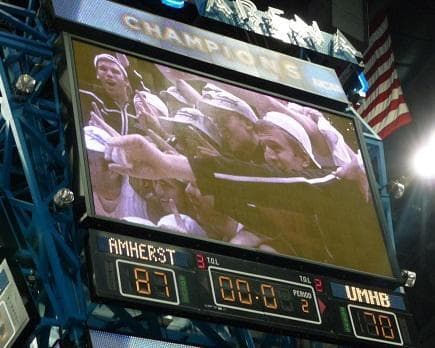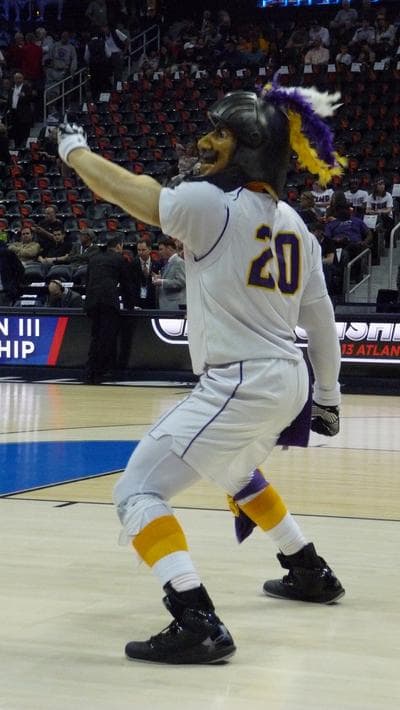Advertisement
Feature
D-III Men's Basketball Championship Steps Onto The Court With D-I
Resume
Here’s an apparent oxymoron: a record-setting crowd at Atlanta’s Philips Arena that fills only about one-third the seats.
But that’s how it worked out when 6,300 fans watched the Crusaders of the University of Mary Hardin-Baylor take on the Amherst College Lord Jeffs for the 2013 Division III men’s basketball title.
It was the first time in NCAA history that the championships for divisions II and III were played at the same venue as the D-I matchup.
The game had all the workings of the Division I championship: Televised live on CBS, pep bands and cheerleaders.
The unranked Crusaders never enjoyed a lead, but were scrappier against No. 2 Amherst than the 87-70 final score reflects.
"When you’re a kid growing up, the only thing you want to do if you’re a basketball player is play in the NBA,” said Amherst All-American Willy Workman.
And at the post-game press conference it was hard to tell whether he was more excited about a national title…or about playing on an NBA court.
“That’s what I’ve wanted to do for as long as I can remember,” Workman said. “So when I heard that it was going to be played in Atlanta — the championship game — and it was going to be at Philips Arena — I was overjoyed. We set our minds to it that we were going to get here and play in this arena.”

6’1” guard and Lord Jeffs star player Aaron Toomey seemed equally smitten by the venue.
“It’s incredible,” Toomey said. “Like he said, this is what you dream of when you’re a little kid out in the driveway. You dream of hitting a big shot you think in the NBA. But this is as close as we’re going to get at this point. This is what it’s turned into.”
The arena, the crowd, the experience — it made such an impression on Mary Hardin-Baylor head coach Ken Deweese.
“If I could get on my soapbox for a second ... if we don’t all get together and make this a permanent thing, I think we’re slighting our student-athletes,” he said. “The experience these guys have had, the way the NCAA people and the City of Atlanta have treated us, it is something that each team should have an opportunity to aspire to get to, regardless of where the Final Four is. For Division II and Division III, in my opinion, in college basketball, this is the best thing that has ever happened.”
Making the change may seem like a no-brainer. This year brought a crowd twice the size of past years, which have averaged about 2,900 fans according to the NCAA’s tally. And there was a spill-over effect from the big Division I schools’ fans.
Like John Zenner, who drove from Traverse City, Mich. to support Michigan in the Division I championship. He couldn’t find tickets, so he figured he’d “probably go to the D-II, D-III games.”
“So I’m going to put you on the spot,” I said. “Who’s playing for the D-III championship?”
“I do not know.”
Of the dozen or so Division I fans I talked to, Zenner was the only one planning to attend the lower division games.
So Division III’s championship might have a ways to go before it enjoys a high-profile status. But you’d be hard-pressed to find anyone who didn’t agree this year’s combined games afforded a once-in-a-lifetime opportunity for Division III players.
But here’s the thing: Division III is different. And that's by design, which is why Amherst head coach David Hixon was less enthusiastic.
“One of the special things about Division III is that the seasons end, and they end a little sooner,” he said. “Kids can play maybe a second sport. Kids have a little more time to actually be students, not just the athlete part, not just the book student part.”
And part of the draw for athletes to Division III schools is that they can be students first. But to line up with the Division I calendar, Amherst and Mary Hardin-Baylor had to play three extra weeks this season. Amherst’s team didn’t get a spring break.
Dan Dutcher, the vice president for Division III at the NCAA, said messing with that balance is a legitimate concern.

“We’re unique as a division in that we have the shortest playing seasons, the most restrictive numbers of contests,” he says. “We don’t permit red-shirting. We don’t permit athletics aid. All of those principles, all of those legislative standards are designed to try to encourage student athletes to have more time to address their academic needs and to be regular students.”
Dutcher said the NCAA is open to a change in how Division III holds its basketball championship, but before that happens, colleges would have to weigh in. And some have.
A straw poll found two-thirds of Division III schools opposed to combining championships if it meant a longer playing and practice season.
And then there’s the practical side of it. And by practical, I mean financial.
“The NCAA really doesn’t make money on Division III,” he said.
This year, Division I chipped in about $250,000 just to bring Division II and III’s teams to Atlanta.
There’s no timeline for a final decision on combining championships. But Dutcher said the NCAA would need nine to 12 months at minimum to plan for a change.
That could mean this year’s Division III championship really was a once-in-a-lifetime deal.
This segment aired on May 11, 2013.